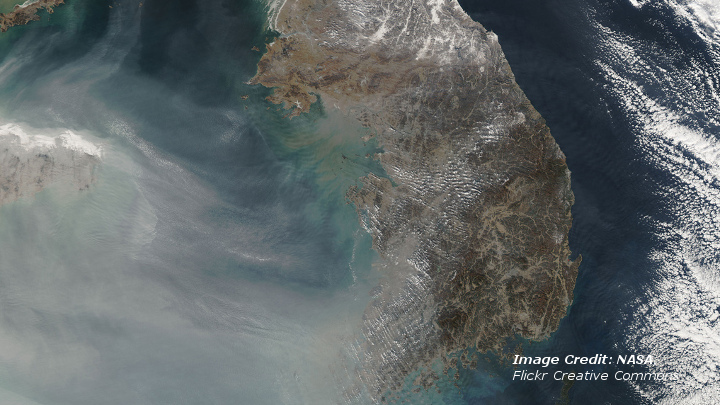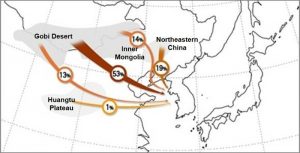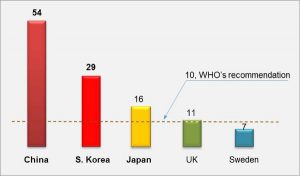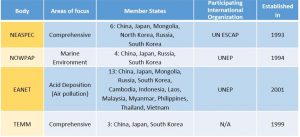Environmental Challenges and Cooperation in Northeast Asia

Woosuk Jung
Ranging from transboundary air pollution to maritime degradation, the countries of Northeast Asia face serious environmental threats that necessitate effective regional cooperation. This paper seeks to provide a concise and accessible overview of the main environmental challenges facing the region as well as provides a summary of the existing mechanisms to deal with them. In so doing, the author outlines the latter’s main limitations and provides recommendations for how cooperation can be enhanced.
Key Points:
- Transboundary environmental challenges including dust and sand storms, air pollution, and marine degradation have become major concerns in Northeast Asia. Not only do they result in adverse impacts on human health and the environment, but also political and diplomatic conflicts over national borders. Among them, transboundary air pollution is the top priority to resolve, with China’s air pollution and resultant flows to Japan and South Korea having become particularly serious in recent years.
- Several multilateral environmental cooperation has been established since the early 1990s to deal with threats and challenges. These include the North-East Asian Sub-regional Programme for Environmental Cooperation (NEASPEC), the Northwest Pacific Action Plan (NOWPAP), Acid Deposition Monitoring Network in East Asia (EANET), and the Tripartite Environment Ministers Meeting (TEMM). Countries also cooperate on a bilateral level.
- Although there have been some achievements through cooperation, such as launching joint monitoring projects and sharing data collection, outcomes have been found wanting in terms of redressing the threats faced. Efficiency of cooperation is hampered by mainly three factors: conflicting priorities and competition between the nations; overlapping responsibilities and lack of coordination; and a lack of binding environmental regimes.
- To enhance multilateral environmental cooperation, there is need to: establish binding conventions and regimes that set reduction targets, especially in tackling transboundary air and marine pollution; expand cooperation in emerging areas such as greenhouse gas reduction and hazardous chemical management; and improve the coordination of multilateral cooperation, in particular between NEASPEC and TEMM, while expanding the number of participating nations, such as including Russia and Mongolia.
Since the 1990s, environmental pollution and degradation has emerged as a major challenge for the Northeast Asian countries as a consequence of the rapid industrialization and urbanization of the region, in particular China. The transboundary implications of these challenges are clear with pollution – both airborne and maritime – transcending national boundaries in ever larger quantities. Threatening not only to the environment but also human health as well as imposing high costs on the economies of the region, there is urgent need to try and tackle Northeast Asia’s growing environmental crisis. While cooperation started already in the early 1990s, it was not until the mid-2000s that greater priority was attached to the role of multilateral cooperation. As a result, a number of initiatives and mechanisms, prominent among them the Tripartite Environment Ministers’ Meeting and North-East Asian Sub-regional Programme for Environmental Cooperation, have sought to address environmental issues in a cooperative framework.
However, they have also been beset by a number of shortcomings that have undermined their effectiveness, ranging from a lack of funding, overlapping responsibilities, as well as failure to institute more binding regimes regarding compliance to mutually agreed on reduction targets. In fact, even the realization of the necessity of (and commitment to) environmental cooperation in Northeast Asia among all stakeholders is relatively low compared to other regions such as Europe. It is furthermore subordinated to other concerns in a region where formal cooperation has been thwarted by tensions and territorial disputes that have dominated policymaking agendas. And yet, failure to cooperate more effectively will not raise the costs of environmental damage but also harbor the potential to exacerbate tensions.
This paper will assess the main environmental challenges in Northeast Asia, analyze the current state of environmental cooperation in the region, and suggest policy strategies to enhance cooperation to counter environmental threats. In so doing, it focuses mainly on China, South Korea, and Japan as the three largest countries of the region.
Environmental Challenges
Northeast Asia faces a number of serious environmental challenges, whose causes and effects are local, regional, and global in character. This section provides an overview of the main environmental issues that are predominantly regional in terms of their transboundary consequences and which, therefore, necessitate particularly close cooperation among the countries of the region to deal with. Three of the main challenges include dust and sand storms resulting from desertification, air pollution, and marine pollution in adjoining sea areas.
Dust and Sand Storms
Dust and sand storms (DSS, also referred to as yellow dust or Asian dust) constitute one of the major environmental concerns in the region. Originating principally in arid areas such as Inner Mongolia in China and the Gobi Desert in Mongolia (as well as increasingly north-eastern China), wind-borne dust particles are carried east affecting not only China, but also the Korean Peninsula and Japan.
The main cause of DSS is the rapid expansion of desertification in China and Mongolia, which has been accelerated by the degradation of land from overgrazing by livestock, deforestation, the gathering of fuel-wood, and mismanagement of water resources. In China alone, areas prone to desertification account for 34.6 percent of the total territory. To the north, desertification affects approximately 77 percent of Mongolia’s territory. As a result, affected lands are more susceptible to wind erosion.
DSS have significant impacts on human health (they are linked to respiratory and skin diseases), the environment, and the economy; such storms may damage buildings and land, as well as paralyze infrastructure such as transportation hubs (in particular airports), communication networks, and power and water supply systems. This is further exacerbated when combined with anthropogenic air pollutants such as sulfur oxides, nitrogen oxides, and heavy metals.
South Korea is one of the countries most affected by DSS. One such storm in 2002 saw particulate matter (PM) concentrations reach a record high of 2,266 μg/m3 , which is 22 times higher than South Korea’s environmental standard (in 2015, the highest figure was 1,044 μg/m3 ). As a consequence, 4,949 kindergartens and schools were closed; 102 flights were canceled; and a number of factories were forced to cease operations. The estimated socio-economic cost amounted to US$ 5.6 billion. Japan is also affected by such storms, although not as severely as South Korea. The occurrence of DSS, moreover, is on the rise. It is calculated that the annual frequency of DSS in Seoul has more than tripled from 3.9 days in the 1980s to 12.6 days in the 2000s. Furthermore, whereas in the past such storms principally occurred in the spring with the thawing of the land after winter, they are now occurring in the autumn as well due to the influence of climate change.
Figure 1. Origin of DSS and Routes (2002-2011)
Source: Korea Meteorological Administration
Fine Dust and Transboundary Air Pollution
Unlike dust and sand storms, fine dust, an air pollutant which was included as a Group 1 Carcinogen in 2013 by the World Health Organization (WHO), primarily originates from the combustion of fossil fuels from coal-fired thermal power plants and transportation. In particular, ultrafine dust known as PM2.5 (particulate matter with a diameter of 2.5 micrometers or less) can easily penetrate human skin and the respiratory system, thus causing respiratory, cardiovascular, and cerebrovascular diseases. An additional issue is acid deposition or rain (which is also a consequence of anthropogenic air pollution) albeit whose impact is less documented than other regions.
Since 2013, there have been increased occurrences of severe smog throughout Northeast Asia as China’s air quality has worsened, resulting in the highest record of PM2.5 recorded in Beijing in January 2013: 993μg/m3 , nearly 40 times higher than the 24-hour mean concentration of 25μg/m3 recommended by the WHO. According to a study conducted by the research organization Berkeley Earth in 2015, it is estimated that 17 percent of all deaths in China are attributable to air pollution. The frequency of fine dust warnings in Seoul, which are issued whenever PM10 concentrations of 120μg/m3 or more persists for more than two hours, increased from there being no alerts in 2012, to two and four alerts in 2013 and 2014, respectively.
It is estimated that China’s air pollutants significantly contribute to the air pollution of both South Korea and Japan. According to a 2010 report of the Long-range Transboundary Air Pollutants project, China accounts for approximately 70 percent of atmospheric nitrogen oxides (NOx), especially during the winter season. South Korea’s air pollutants are also reported to travel to Japan, although in lesser quantities than those originating from China.
Although China is attempting to reduce air pollution by, for example, setting a reduction target of PM2.5 concentration of 60μg/m3 in Beijing by 2017, the reality is still bleak; Beijing’s annual PM2.5 concentration went up from 85.1μg/m3 in 2008 to 97.7μg/m3 in 2014. Both values far exceed the annual mean concentration of 10μg/m3 recommended by the WHO.
Figure 2. PM2.5 Annual Mean Concentration in 2013, μg/m3
Source: Compiled from World Bank data
Degradation of Marine Environment
Northeast Asian seas comprise the Yellow Sea (including the Bohai Sea), the East China Sea, and the East Sea (also referred to as the Sea of Japan). All seas are witnessing increasing levels of marine degradation. The primary challenges faced by the seas in the region are as follows: harmful algal blooms known as red or green tides resulting from eutrophication; maritime environmental accidents such as oil spills; increasing threats to biodiversity including the introduction of alien species; and marine litter.
Harmful algal blooms or eutrophication cause massive deaths of fish and other marine animals by oxygen depletion (known as hypoxia) and the toxins produced. Such blooms are in turn caused by the abundance of nutrients from rivers and air, such as nitrogen and phosphorous substances, which flow into the sea. This phenomenon also represents a threat to human health through bio accumulation of toxins in the food chain. It is reported that around 50 so-called “red tides” occur annually—mostly in the East Sea area, but also on the western coastlines of the region. Due to the substantial contribution of air pollution to the increasing influx of nutrients, the occurrence of algal blooms is projected to increase.
Oil and Hazardous Noxious Substances (HNS) spills are another environmental hazard significantly damaging marine ecosystems. Between 1990 and 2011, a total of 338 oil and HNS spills were recorded in the region. The main cause of spills is through ship-to-ship collisions, partly due to the high shipping density in Northeast Asian seas, in particular in the Yellow Sea. Furthermore, marine biodiversity in the region is also decreasing over time. It is estimated that 60 of 194 species are at risk of extinction. Invasion of alien species, overfishing, warming sea temperatures, and aquaculture are the key contributing factors. Indeed, the fast growth of fishery and aquaculture in the region is profoundly changing the ecosystem and food chain patterns. The annual fish catch in the Yellow Sea, for instance, has steeply increased from 0.2 to 2.2 million tons over the course of the past fifty years, with aquaculture in the region having dramatically increased by 1,200 percent over the last thirty years.
Finally, marine litter is a significant problem in Northeast Asian seas. The effects are predominantly three-fold: it pollutes marine waters and coastlines, diminishes marine productivity through blocking sunlight, and represents a threat to flora and fauna that may consume it. It is reported that 536 items of marine litter per 100m2 are washed up monthly in Korean seas. Between 1.32 and 3.53 million tons of plastic waste reportedly entered into the ocean from China’s coastal area in 2010 – the highest of any country.
Other Environmental Issues
While not treated here in depth, in addition to the above challenges, greenhouse gas (GHG) emissions and the emerging issue of hazardous chemicals also necessitate cooperative responses from all countries of the region.
In the case of GHG emissions, Northeast Asian countries should share a substantial burden in the fight against climate change since they significantly contribute to global GHG emissions. In 2014, China, Japan, and South Korea ranked 1st, 5th, and 10th in terms of global carbon dioxide emissions with 27, 3.4, and 1.7 percent of the total contribution, respectively. As Northeast Asian countries are dependent on high-CO2-emitting industries, cooperation over GHG reduction is of pivotal importance globally as well as regionally.
Hazardous chemicals represent another regionwide concern. The most recent case was the chemical explosion in Tianjin, China, in August 2015, which gave rise to fears of toxic chemical migration to neighboring counties. Moreover, considering the enormous amounts of hazardous chemicals being traded across the nations’ borders, a unified management system to prevent chemical accidents is needed.
In sum, all the environmental challenges identified above show some common features: their impacts are transboundary, it is difficult to address the problems through exclusively unilateral efforts, and the region bears responsibility for placing a heavy burden on the regional and global environment. This is why such challenges necessitate targeted actions within a cooperative framework among the Northeast Asian countries. Existing fora and mechanisms to deal with environmental issues in the region are outlined below as well as their main limitations identified.
Regional Environmental Cooperation
Table 1. Multilateral Environmental Cooperation
Attempts at environmental cooperation in Northeast. Multilateral Environmental Cooperation Asia – both bilateral and multilateral – already stretch back several decades. The Symposium of South Korea-Japan Environmental Science took place in 1988 and was the first environmental forum in the region; two experts from China also participated as guests. In 1992, the Symposium evolved into a multinational conference and was renamed the Northeast Asia Conference on Environmental Cooperation (NEAC). Its participation was extended to nations such as China, Mongolia, and Russia, and its participants ranged from central and local government officials, to non-governmental organizations and scientists. With growing awareness of the importance of environmentally sustainable development following the Rio Earth Summit in June 1992, NEAC ushered in a plethora of other environmental cooperative bodies, such as the NorthEast Asian Sub-regional Programme for Environmental Cooperation (NEASPEC), the Northwest Pacific Action Plan (NOWPAP), Acid Deposition Monitoring Network in East Asia (EANET), and the Tripartite Environment Ministers’ Meeting (TEMM) to discuss issues of concern, especially linked to transboundary air and marine pollution.
Environmental cooperation is presently proceeding along two main axes: multilateral bodies and bilateral initiatives between nations. The main multilateral bodies are considered first. The North-East Asian Sub-regional Programme for Environmental Cooperation (NEASPEC). Proposed by South Korea at the conference of the United Nations Economic and Social Commission for Asia Pacific (UNESCAP) in 1992, NEASPEC was established in 1993 to promote comprehensive environmental cooperation in the region. NEASPEC includes six member states (China, Japan, Mongolia, Russia, South Korea, and North Korea), as well as UNESCAP.
NEASPEC is involved in dealing with various environmental issues such as transboundary air pollution, DSS and desertification, nature conservation, marine protection, as well as establishing eco-efficient partnerships. It has a secretariat in Incheon, South Korea, and a Senior Official Meeting (SOM) serves as the main decision-making body.
One of the most significant projects under NEASPEC involved collaboration on mitigation of transboundary air pollution from coal-fired power plants between 1996 and 2012. The project included member countries preparing air pollution abatement plans and helping China and Mongolia’s power plant operators build the technical capacity and best practices to reduce sulfur oxide emissions.
Notwithstanding, NEASPEC is beset by several structural issues. One is the inconsistency of the responsible bodies in the different countries. In the case of China, North Korea, and South Korea, responsibility falls within the foreign ministries, while in Japan, Mongolia, and Russia the main ministry responsible is the environment ministry. This serves to impede communication and slows down the decision-making process. In addition, due to its broad mandate, NEASPEC’s work often overlaps with other organizations more focused on one specific issue, which can lead to duplication of efforts and inconsistency of approaches.
The Northwest Pacific Action Plan (NOWPAP). As a part of the UNEP Regional Seas Programme, which currently runs in 13 regions across the world, NOWPAP was launched in 1994 by four member states (China, Japan, South Korea, and Russia) to promote sustainable management and use of the coastal and marine environment and its resources.
NOWPAP’s focus area includes the Yellow Sea and the East Sea/Sea of Japan. However, the Bohai Sea, the most polluted waterbody in the area, is significantly not included. Financed by its member states, NOWPAP has four Regional Activity Centers (RACs) in each state as project-implementing bodies, two Regional Coordinating Units (RCUs) in Japan and South Korea as secretariats, and an Intergovernmental Meeting (IGM) as a decision-making body.
Accordingly, NOWPAP functions as an information hub for marine pollution, national legislation and policy on oceans, joint monitoring projects, and response to ocean pollution such as oil spill accidents. In 2004, a Memorandum of Understanding on Co-operation Regarding Preparedness and Response to Oil Spills in the Marine Environment was agreed upon and signed by the NOWPAP member states.
In spite of being guided by a mid-term strategy (MTS) and annual action plans, it has not developed targets or indicators enabling accurate assessments of the quality level of the marine environment. Furthermore, in terms of outputs, the performance of NOWAP has been rather underwhelming; in over twenty years since its establishment, an assessment on the holistic status of the marine environment of the seas has been published only twice, in 2007 and 2014. Funding for NOWPAP also does not appear to be sufficient; the 2016-2017 plan only budgeted US$950,000 for its four regional centers and two secretariats. Running two secretariats, partly due to competition between Japan and South Korea, is contributing to budget shortages to some extent. In view of a lack of funding and capacity, two important projects – one regarding ballast water which is considered to be a carrier of alien species, and one tackling climate change impacts – have been suspended since 2012 when the 2012-2017 MTS was adopted.
Acid Deposition Monitoring Network in East Asia (EANET). On the occasion of the first NEAC meeting in October 1992, Japan announced the necessity of cooperation among East Asian nations to monitor acid deposition (also known as acid rain). Japan’s initiative was inspired by and modeled upon the European Monitoring and Evaluation Program (EMEP) under the Convention on Long Range Transboundary Air Pollution (CLRTAP) of the UN Economic Commission for Europe (UNECE). After several years of negotiations and preparatory projects, EANET was finally inaugurated in January 2001 as a formal intergovernmental network. Currently, 13 countries are taking part in the project: China, Japan, Mongolia, Russia, South Korea, Indonesia, Malaysia, Philippines, Thailand, Viet Nam, Cambodia, Laos, and Myanmar.
EANET consists of a Network Center (NC), a Scientific Advisory Committee (SAC), a working group, a Secretariat, and an intergovernmental meeting as the main decision-making body. The Secretariat is operated by UNEP. Its funding comes from volunteer contributions from the participating countries. Unlike the other cooperative bodies described here, EANET’s geographic focus is East Asia as a whole but it only addresses the issue of acid rain or deposition.
As such, EANET has successfully established a network of 56 monitoring sites across the region for acid substances such as sulfate and nitrate, and it has implemented standardized monitoring techniques which enable the comparison of national data across countries. Such mechanisms enable the monitoring, analysis, and evaluation of data on acid deposition.
However, its progress has been marginal in terms of joint-policy development, as its activities center rather on scientific research. Furthermore, its focus on acid rain (the effects of which have been better documented in Europe, for instance) is not a priority issues for the region. Accordingly, EANET is trying to expand its scope to include air pollution issues such as fine dust and tropospheric ozone. However, some member states such as Malaysia are strongly opposing the shift, arguing that EANET has to focus more on capacity-building for acid deposition monitoring instead. Furthermore, if an expansion of scope is indeed in order, EANET should be aware of potential duplication issues with other cooperative bodies such as NEASPEC, the Long-range Transboundary Air Pollutants (LTP) project under the Tripartite Environment Ministers’ Meeting (TEMM), and the Association of Southeast Asian Nations (ASEAN) agreement on Transboundary Haze Pollution.
Tripartite Environment Ministers’ Meeting (TEMM). Spurred by South Korea’s initiative, the environment ministers of China, Japan, and South Korea have held annual meetings since 1999. The TEMMs are hosted by each nation on a rotating basis once a year and deal with an extensive range of environmental issues. In 2014, the environment ministers of the three countries identified nine priority areas including air quality, hazardous chemicals, resource-waste circulation, and climate change, as well as agreed to make a concerted effort to prevent and reduce air pollution.
While started as an independent project, one of the most relevant outcomes has been the LTP project, which TEMM supports, with the attending agencies of LTP being the national environmental research institutes under the environment ministries of each country. Over more than 15 years of monitoring transboundary air pollutants since 2000, the LTP project has developed a source-receptor relationship model and thereby analyzed the contribution of alien pollutants to national air pollution. This is significant because it forms the scientific basis for developing action plans to reduce pollution. In 2007, furthermore, the TEMM launched a large-scale joint project against DSS consisting of a Tripartite Director-General meeting, two working groups, and a steering committee; the activities of the project included establishing monitoring and early warning networks, as well as providing scientific knowledge for decision-makers, for instance of the impacts on health.
In spite of this, TEMM’s progress is considered by many to be insufficient, even though it has stronger enforcement power due to its direct ties with the three countries’ environment ministers. The overlap with other cooperative bodies, in particular NEASPEC, is also an issue to be addressed in regard to the efficiency of TEMM.
Bilateral Cooperation
Bilateral environmental cooperation between Northeast Asian countries began in the early 1990s. Japan has pursued bilateral cooperation as a diplomatic measure using Official Development Assistance (ODA) and signing agreements on environmental cooperation with Russia in 1991, with South Korea in 1993, and with China in 1994. A milestone of Sino-Japanese cooperation was reached in 1996, when the Sino-Japan Friendship Center for Environmental Protection was established thanks to Japanese funding. The Center conducts joint research, and through the Center Japan has contributed to China’s environmental capacity building, supporting a training program for Chinese staff members; more than 3,700 of them have studied at Japanese universities.
South Korea established bilateral agreements on environmental cooperation with China in 1993, and with Russia in 1994. In 2007, the country also signed a Memorandum of Understanding with Mongolia on the monitoring, research, and conservation of nature reserves. South Korea’s bilateral efforts are particularly evident in regard to the DSS threat. The Korea Forest Service, for instance, has launched small-scale forest plantation projects in China and Mongolia.
Bilateral environmental cooperation between China and Russia has been regularized as a sub-committee of the prime ministers’ meeting since September 2006. This was instituted 10 months after the Songhua River spill accident, when 100 tons of toxic substances including benzene leaked from a petrochemical factory explosion in Jilin, China, and flowed into Russian territory, causing water contamination and public concern in Russia. Against this backdrop, environmental cooperation between the two countries is focusing on the prevention of water pollution in the bordering river basin area, in particular the Heilongjiang River (also referred to as the Amur River). The conservation of endangered species, in particular the Amur tiger and leopard, is another focal point: the two nations agreed to establish the first cross-boundary protection zone in 2010 in the Tumen River area.
In sum, cooperation has traditionally been carried out in the form of aid from more economically developed countries, namely Japan and South Korea; however, after the mid-2000s when China experienced greater economic development, the focus of environmental cooperation in the region shifted to a greater focus on multilateral cooperation. Furthermore, while bilateral and multilateral cooperation efforts have proven largely complementary, in certain cases the former has proven a more effective tool when discussing more sensitive issues. For example, in the case of pollution in the Yellow Sea, bilateral channels between South Korea and China have proven more effective than multilateral frameworks.
Shortcomings of Cooperation
As reviewed above, Northeast Asian countries have developed a variety of forms of environmental cooperation over the past decades to address the challenges facing the region. Through cooperation, some progress has been accomplished especially in joint monitoring and data-sharing projects, which forms the basis for understanding the challenges and developing policies to mitigate them. The LTP project on transboundary air pollution is a case in point.
Notwithstanding, progress has generally been slow, with implementation of region-wide reduction targets and standards, for example on air pollutant emissions and water quality, absent, and many of the environmental challenges such as transboundary air pollution having gotten worse. The main shortcomings are further elaborated below.
Conflicting Priorities and Competition
Conflicting priorities between the countries of Northeast Asia are serving to impede more efficient cooperation. For example, whereas South Korea prefers to deal with environmental issues through intensifying cooperation between Northeast Asian countries, Japan shows a preference for larger pan-East Asian arrangements such as EANET. One reason for this is that South Korea is more greatly influenced by transboundary pollution from the immediate neighborhood than is Japan. Accordingly, it is South Korea which has had a greater interest and stake in initiating multilateral cooperation in Northeast Asia, namely NEASPEC and TEMM.
What is more, China and Russia have not assumed active roles in environmental cooperation in the region. China’s main focus is not on the consequences of environmental damage in neighboring countries but rather on its own domestic environmental problems. Thus, unlike its eagerness to take a leading role in economic cooperation in Asia, it is rather inactive in environmental cooperation. Russia, for its part, notwithstanding the abovementioned projects, pays relatively little attention to environmental issues in the Russian Far East.
Some argue that strong leadership is needed in order to spur more effective cooperation. However, given rivalries and geopolitics in the region, the question of which country should take a leading role is not an easy one. For example, the fact that NOWPAP has two secretariats – one in Toyama, the other in Busan – is illustrative of a failure to agree.
Overlap of Activities and Lack of Coordination
Relatedly, the different interests and competition between (and within) countries is also causing an overlap of environmental activities pursued by multilateral bodies. This has especially proven the case in efforts to combat air pollution. On the one hand, South Korea is putting more efforts into the LTP project of TEMM; on the other, Japan is leading efforts to change EANET’s focus from acid deposition to transboundary air pollution, with a subsequent duplication of efforts.
Lack of communication between ministries, especially in the case of South Korea, is a further factor. For example, NEASPEC was initiated by the Ministry of Foreign Affairs while TEMM by the Ministry of Environment. The two extensively overlap with each other due to their similarities in terms of the scope of activities.
In addition, international organizations have launched similar cooperation projects, for instance in terms of marine environmental cooperation: the Yellow Sea Large Marine Ecosystem (YSLME) project which is managed by the UNDP overlaps with NOWPAP’s activities supported by UNEP.
Lack of Binding Environmental Regimes
The lack of a binding regime also serves to retard significant outcomes. Unlike such regimes in other regions which have proven effective, such as the Convention on Long-Range Transboundary Air Pollution (CLRTAP) which has significantly contributed to reducing air pollution in Europe, there is no regional environmental convention in Northeast Asia that establishes a long-term vision coupled with binding regulations to achieve it. One of the reasons for this absence is probably associated with the reluctance of China, which due to its disproportionate size has considerable responsibility for the environmental challenges in Northeast Asia, to accede to such. In addition, as examined above, competition between countries over leadership of formats also impedes the development of binding conventions.
Conclusion and Recommendations
Environmental cooperation in Northeast Asia is not only essential for defusing environmental threats and challenges in the region; but also fostering cooperation in “softer” areas can also serve as a means by which to alleviate political tensions. With these goals in mind, Northeast Asian nations have pursued environmental cooperation both at multilateral and bilateral levels, with specific bodies established charged with coordinating cooperation.
Nevertheless, the results of efforts thus far have rather consultative and revolving around information sharing. As a result, the environmental problems identified in this paper – from the consequences of desertification to transboundary air pollution and maritime waste – remain acute. Conflicting priorities, overlapping cooperation bodies, and a lack of environmental regime with binding regulations are all factors inhibiting greater success.
Moreover, China, by virtue of its size, is the largest contributor to environmental degradation and its transboundary impacts. However, there are reasons for hope. Having increasingly recognized the seriousness of environmental damage, the CCP’s 13th Five-Year Plan (2016-2020) has an explicit focus on improving the environment. Thereby it is projected that China will become a more active participant in cooperation initiatives.
Finally, this paper puts forward the following policy recommendations.
1. Establishing Binding Conventions
Air pollution (including fine dust and DSS) is the most pressing environmental issue in the region. Northeast Asian countries should establish a Multinational Air Pollution Control Convention able to set and enforce targets for emission reductions, at the same time designing long-term projects to tackle desertification and unsustainable land use.
NEASPEC and its six member states can become the building block for such a convention, while TEMM can be reorganized as the central body for environmental cooperation in the region, dealing with comprehensive environmental issues and facilitating other multinational projects conducted by governmental and private actors.
In the case of the marine environment, binding frameworks should also be introduced. The Helsinki Convention to protect the Baltic Sea area adopted in 1974 offers a good example to follow, with tight regulations on the activities of the stakeholders. Similarly, NOWPAP should be transformed into a binding cooperation convention.
2. Expanding Scope of Cooperation Area
The establishment of joint policies and standard regulations across nations is needed to deal with issues such as greenhouse gas emissions and hazardous chemicals. This can serve to optimize time and resources by sharing experiences and best practices. For example, the EU countries have unified hazardous chemical management institutions and codes so that chemicals are systematically monitored and managed across EU borders.
One recommendation for Northeast Asia, furthermore, is that China, Japan, and South Korea share a greenhouse gas trading market similar to the EU. South Korea and Japan (albeit not nationwide) started a domestic trading market in 2015 and 2005, respectively, while China will do so in 2016. However, a region-wide trading market remains absent.
Environmental industry and technology are also an emerging area for purposes of cooperation. South Korea and Japan can, for example, strengthen assistance to China to enhance its air pollution management capacity through offering technological education or investment in environmental facilities. As the former are significantly affected by China’s air pollution, it is a win-win measure for all sides.
3. Expanding Participation and Reducing Overlaps
TEMM should open its membership to include Mongolia, North Korea, and Russia. This would not be a significant leap in membership as NEASPEC already includes these nations, and all countries (except North Korea) regularly hold bilateral meetings. In particular, North Korea’s participation is critical because the country is suffering from serious environmental degradation. One example is deforestation, which is linked to a decline in agricultural productivity and increased vulnerability to disasters such as floods and droughts.
In conclusion, transforming NEASPEC into a convention on transboundary air pollution, turning NOWPAP into a convention on the marine environment, enlarging the scope and power of TEMM, and setting up a joint environmental protocol to tackle new environmental challenges will streamline the current overlap in terms of activities and introduce more binding regimes, thus bringing about considerable improvements in Northeast Asian environmental cooperation. While cooperation has certainly made progress in the past two decades, there remains much still to be done.







